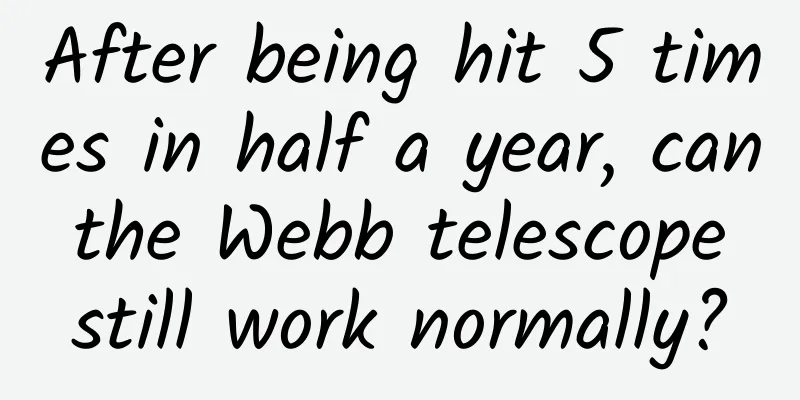After being hit 5 times in half a year, can the Webb telescope still work normally?

|
The Hubble telescope is known to everyone because it has played an important role in human exploration of the universe. As the successor to Hubble, the Webb Space Telescope will be able to see farther, which means it will be able to discover more mysteries of the universe. However, all this is based on its ability to continue to work for a long time. In fact, the future of the Webb Telescope is a bit worrying because it has such a bad fate. It took more than ten years from the beginning of the development of the Webb Space Telescope to its official launch. Why did it take so long? Because the Webb Telescope must be in a foolproof state before launch. Unlike Hubble, the Hubble Telescope is located 575 kilometers above the surface of the earth. It can be said that it is right next to us, so we can repair and debug it at any time. The Hubble Telescope has undergone many repairs, both large and small, during its operation. For example, in 1993, the solar panels of the Hubble Space Telescope were hit, and NASA sent out seven astronauts to repair and replace them. It is precisely because the Hubble Telescope is close enough to us and can be maintained and debugged at any time that the Hubble Telescope, which was originally designed to have a lifespan of only five years, has been in service for more than 30 years. But the Webb Space Telescope is not like that. It is going to the Earth-Sun L2 Lagrange point 1.5 million kilometers away from the Earth. The farthest planet that humans have personally set foot on is the moon, which is about 380,000 kilometers away from the Earth on average. At present, humans do not have the ability to go to a place 1.5 million kilometers away, let alone send people to that far for maintenance and debugging, so it must be guaranteed to be foolproof before launching. Why does the Webb telescope have to be thrown so far away? The Webb telescope is fundamentally different from the Hubble telescope. Hubble is a visible light telescope, while Webb is an infrared telescope. The essence of infrared is temperature, so infrared detectors are very sensitive to heat sources. Among the five Lagrange points in the Earth-Sun system, only at the L2 point is the sunlight blocked by the Earth, and it is far enough from the Earth to minimize interference. The reason why it must be placed at the Lagrange point is because it is the gravitational balance point. Only at this point can the Webb telescope always maintain a relatively fixed position with the Earth and the Sun. Fortunately, after finally overcoming many obstacles, the Webb Space Telescope was finally launched on December 25, 2021. Weber's launch was not the perfect ending of the story, but rather the beginning of its ordeal. From launch to final arrival at the L2 point, the Webb telescope experienced 344 single-point failures, 4 of which were caused by micrometeoroid impacts. Didn't humans monitor the trajectory of these micrometeoroids? How could they hit Webb? It is actually very difficult for humans to monitor these micrometeoroids, because they are usually only the size of sand grains. Such small things floating in the universe are difficult to detect with human current observation capabilities. There are many such tiny micrometeoroids in the universe, and most of them fall off from asteroids or comets for various reasons. What does it matter if such a small thing hits the telescope? Don't say that. Although the sand grains are small, they can't withstand the high speed. Look at the holes on the robotic arm of the International Space Station caused by micrometeoroids, and you will know how powerful these high-speed moving sand grains are. Fortunately, the first four collisions did not cause serious damage to the Webb Space Telescope. After reaching the L2 Lagrange point, the telescope was adjusted and finally reached its ideal working state. Just when people thought everything was ready and they were just waiting for the official start of construction, the fifth impact came again on May 24, 2022. The fifth impact was completely different from the previous four, because the micrometeoroid this time was larger in scale and collided head-on with the Webb telescope. What's more, it was the main mirror that was hit. After the impact, it was obvious that the main mirror was misaligned. For infrared space telescopes, the primary mirror is the undisputed core component, so can the Webb telescope still work normally? NASA engineers have made a series of fine-tuning to the mirror that was dislocated by the impact, and the current conclusion is that "the impact is not fatal, and the telescope can still be officially started in July 2022". Although this impact is not fatal, the Webb telescope still suffered irreparable damage, and more importantly, its future prospects are still worrying. As we have said, micrometeorites are everywhere in the universe and difficult to monitor. In addition, although the L2 Lagrange point is an ideal observation point, because it is too far away from the earth, the micrometeorites here are more susceptible to the gravitational pull of other celestial bodies and deviate from their orbits. Therefore, it is almost certain that this impact will never be the last for the Webb telescope. If it really suffers damage in the future that is difficult to recover through remote debugging, it will have to retire. For more information, please follow the official account: sunmonarch |
<<: How hard is it for roadside trees to provide shade in the summer?
>>: Behind every disease, there is a persistent bad habit!
Recommend
Japan's "Xiang Xiang" and the United States' "Ya Ya" return to China! How difficult is the road to protecting giant pandas?
There were numerous banners, fans were crying wit...
"A bumper harvest" to celebrate the autumn harvest! Wait, what does "a bumper harvest" mean?
In the golden autumn of October, fruits and veget...
How can e-commerce companies operate Douyin private domain well?
With the rise of live streaming platforms and sho...
Do you have promotional abilities?
There are many tasks that operations are responsi...
《Lao Duan said: Ultra-HD box》
Duan Youqiao, an iQiyi artist, today I suddenly w...
First confirmed! There is a source of life outside the Earth! Are there really aliens?
Expert of this article: Yang Chao, PhD in Chemist...
Mazda, the BMW of Japan, may still have a chance to save itself in fuel vehicles
Mazda is known as the BMW of Japan. But when BMW ...
How long does it take to refund the deposit from Douyin Store? What are the benefits of setting up a Douyin store?
This article mainly introduces how long it takes ...
Tofu contains high levels of estrogen. Will men who eat too much become effeminate and women who eat too much get cancer? The truth is out.
Tofu contains high levels of estrogen. Will men w...
What is the proportional coefficient of Baidu promotion? I don't believe you know it all!
At present, the most complete online search promo...
Olympic champion Zheng Qinwen insists on eating chicken breast and broccoli for 360 days. Can ordinary people do the same?
Review expert: Peng Guoqiu, deputy chief physicia...
Table tennis AI reaches intermediate level! Is it no longer a human specialty to deal with the complex physical world?
Table tennis, known as China's "national...
Want to increase followers on Douyin quickly? Please accept the super powerful complete guide to operating Douyin!
Currently, people who use TikTok have two main pu...
Advertising channel costs, optimization and techniques!
Regarding advertising, I shared some experiences ...
Tips and precautions for placing Tik Tok information flow ads!
As an emerging advertising model, information flo...









